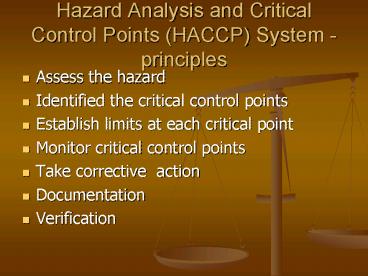Hazard Analysis and Critical Control Points HACCP System principles - PowerPoint PPT Presentation
1 / 8
Title:
Hazard Analysis and Critical Control Points HACCP System principles
Description:
Processing of food (incoming raw food; failure to kill pathogen; contamination ... Determine any food that was produced when the deviation occurred ... – PowerPoint PPT presentation
Number of Views:1827
Avg rating:3.0/5.0
Title: Hazard Analysis and Critical Control Points HACCP System principles
1
Hazard Analysis and Critical Control Points
(HACCP) System - principles
- Assess the hazard
- Identified the critical control points
- Establish limits at each critical point
- Monitor critical control points
- Take corrective action
- Documentation
- Verification
2
Assess the hazard
- Identify the hazards
- Assess the risk for these hazards
- Establish preventive measures
3
Identify the Critical Control Points
- Processing of food (incoming raw food failure
to kill pathogen contamination after
sanitization - Purchasing (vulnerable foods high protein/high
water - Preparation of food thawing, cross-contamination,
heating, holding, serving, cooling/reheating) - Sanitation (cleanup, equipment, facilities, pest
control, water - Storage
- Personnel (training, reinforcement , updates,
feedbacks
4
Establish Limits at Each CCP
- Temperature poultry-82 ground meats-71
pork-71 beef-63 fish-60 reheated foods-74 - Time
- Water and humidity
- pH
5
Monitor CCP
- The purpose is to
- Track the systems operation
- Indicate when loss of control or deviation
occurred - Provide written documentation for use in
verification process
6
Take corrective action
- Determine any food that was produced when the
deviation occurred - Take corrective action so CCP is under control
- Maintain records of any corrective actions taken
7
Documentation
- HACCP team and responsibilities
- description of the product and its use
- hazards associated with each CCP
- critical limits
- monitoring procedures
- corrective action plans,
- record keeping procedures
- procedures used for verification.
8
Verification
- Internal verification (verification of CCP
limits good HACCP Plan - little-end product
sampling is required documented periodic
revalidation - External verification inspection by local and
provincial health authorities - National Surveillance































